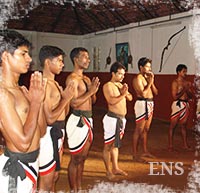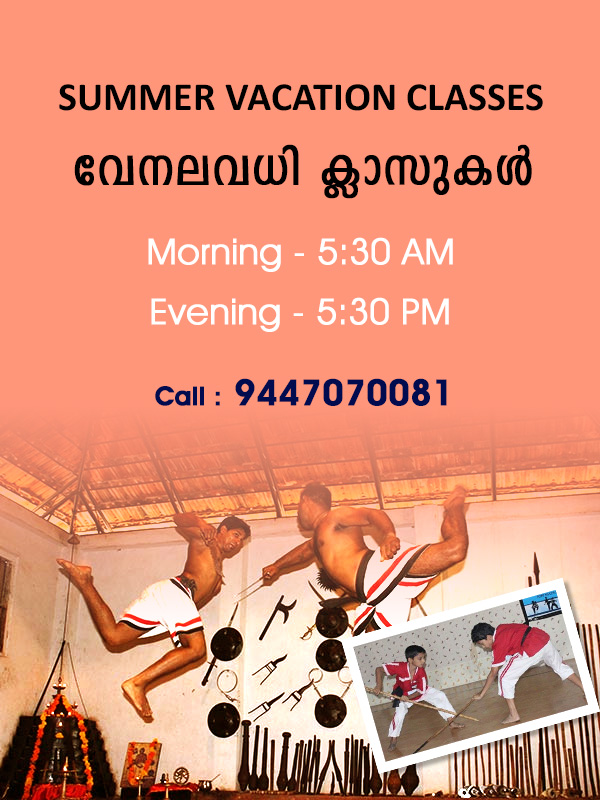A Way of Life

In the medieval period of Kerala, this art was the way of life for warriors, in the traditions of CHAVER PADA [the suicidal death army], ANKA CHEKOR [one who is trained for duels], and for GURUKKALS [masters]. The fighter’s function was not in the rivalry among political authorities alone. Often they were invited for settling disputes between ordinary people. This practice of using fighters for judicial purposes gave rise to the local and regional political authorities. Regular income to the treasury during the rule of the princely states in Kerala included the fees levied on ANKAM combats that were collected from the disputing parties. Thus the martial spirit of Kerala was actively participating in the social and political life of Kerala in the middle age. It is in this socio-political context that the institution of Kalari becomes important as a centre for directing the military activities of the local militia.
AIM OF KALARIPPAYATT
The development of physical culture is an important part of the social-political and economic life. In physical culture, the strength of mind is more important. The aim of Kalarippayatt is not only self-defense and offence, but also the strength of the mind through physical exercises. The strength of the mind is the strength of the body. It enables one to standup to challenges in life and disciplines both mind and body. So it helps to develop a better citizen for the nation.
ADVANTAGES OF KALARIPPAYAT
The ritualistic and spiritual atmosphere in the Kalari plays an important role in forming the character and moral attitude of the students. The present age is very much polluted by greed, lust and aggression. The media spreads these unhealthy messages at great speed. Youngsters especially are drawn down easily to hopeless futures, vague and unhealthy ideals, horrible diseases, sexual mania, isolation, depression and aggression.
Usage of nicotine & alcohol, brown sugar and other drugs are also increasing heavily. In such a hopeless world the Kalarippayatt stands as a hope to the future generation showering forth the light of ancient wisdom, peace, love, compassion, self- improvement, self-realization, dedication, hard work and universal brotherhood.
KALARIPPAYATT & OTHER MARTIAL ARTS
Most of the Martial arts from the present day like KARATE, KUNG-FU, TAK KWAN DO, KENDO, JUDO are highly indebted to Kalarippayatt. Kalarippayatt can be explained as the mother of all these Martial Arts. You can find the basics of these Martial Arts from Kalarippayatt. Let us trace them back to find how Kalarippayat became came bear such vast influence. BODHIDHARMA, whom the Japanese call DARUMA, was an Indian patriarch – the twenty-eighth lineage holder in a line of succession from SHAKYAMUNI–BUDDHA, the founder of Buddhism. Bodhidharma left India for China, arriving there in 520AD and he established himself at SHOALING monastery, which had been founded by the Indian monk Batuo some decades earlier. Bodhidharma passed on his physical training techniques to the monks at shoaling, who integrated them into their spiritual training. These techniques were also used to defend the monastery against bandits who roamed the desolate Chinese countryside.
Buddhism is well established by the third century BC and continued to flourish throughout South India till the fourth Century AD. It began to decline due to the revival of Hinduism and great Aryan Culture. During this period the pallavas were KANCHIPURAM [also Conjeevaram] near Madras, at present the capital of Tamil Nadu State.
BODHIDHARMAN was the son of King SIMHAVARMAN of the Pallava dynasty who ruled from 436-460 AD. It must be true that being a Kshathriya [one who belongs to warrior community],
the Bodhidharman must have learned the fighting techniques. Inevitable, in the Royal family has to undergo the training for Martial Arts. It is a must for every Kshathriya to study the Martial Arts. Naturally Bodhidharma also learned Kalarippyatt. Furthermore, there was a catastrophic flood during that time which forced all the citizens of Kanchipuram, badly affected by the flood, to move to VANCHINAD [i.e.The southern part of Kerala].
Naturally Bodhidharma must have further studied the Kalarippayatt of the ‘THEKKAN’ [Southern style of Kalarippayat], which is prevalent in that area. Incidentally, the movements and steps of Karate and Kung fu are closer to the Thekkan style than the VADAKKAN [Northern style of Kalarippayat].
Before the arrival of Bodhidharma, Buddhism was gaining more acceptance in CHINA. Many buddhist missionaries went to China and they carried with them the tradition of Indian Art, and it is possible that Indian artists and craftsmen also went. Even before the death of CHRIST, India and China had business connections.
Due to the decline of the Buddhism in India following widespread opposition and the aggressive attitude of HINDUISM, most of the prominent Buddhists fled to neighboring countries. China was one of the countries which welcomed Buddhism and within no time it was widely accepted. Bodhidharma was an ordinary priest. He was esteemed among the Buddhists as the 28th patriarch of the church and as a legitimate practitioner of the fist Apostles of SAKYAMUNI, the rightful occupant of the chair in which the MAHAKASHYAPA sat during the first council immediately after the master’s death. The troubles that occurred in India undoubtedly had something to do with Bodhidharma’s visit to China but apart from that, he had also come to fulfill a mission of reform. From the above, we can conclude that most of the Martial Arts originated from Kalarippayat and it can be considered as the MOTHER of all the Martial Arts developed in the Orient.

 Online Class
Online Class